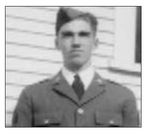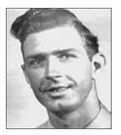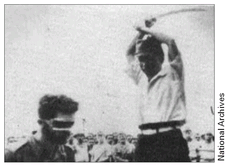War Stories II (12 page)
Authors: Oliver L. North


PRIVATE ANDREW MILLER, US ARMY
Nichols Field, Philippines
6 May 1942
Nichols Field, Philippines
6 May 1942

After the first air attacks in December, we were moved from Nichols Field to Bataanâa peninsula with Manila Bay on one side and on the other side was the South China Sea. The Harbor Defense Group and their big guns on four different islands in the mouth of the bay protected the entrance to the bay. Corregidor was the biggest and best fortified of these islands. The idea was to hold out until the Navy could escort ships over to support us. Well, it never happened.
When my unit got sent to Bataan we were positioned at about kilometer mark 133. I guess you'd call it the front line, but the Japs called it the main line of resistance. The Jap offensive started on 3 April on our left flank. They never shot where we were at all. They'd send an occasional artillery round just to let you know that they knew you were there. On the night of 6 April the medics came in and took the men who had malaria the worst back to one of the hospitals.
On the afternoon of the eighth, we were on a hill, and they weren't too far away from us, and quite a few men got hit. For some of the men
the only thing we could do was ease their pain with a shot of morphine, because there was no way you could save them.
the only thing we could do was ease their pain with a shot of morphine, because there was no way you could save them.
But the sun finally came up and somebody told us that they were trying to arrange a surrender. Well, we didn't think that was such a good idea. So we made it down to the beach and found an outrigger canoe. Then we started out for Corregidor, which was not such a smart move. The tide was going out, and there's a current in the bay. We got out about a quarter mile or so, looked over to Corregidor, and saw nothing but smoke and dust. We looked back at Bataan and it was the same thingâa lot of fire, everything was a mess. Airplanes were all over the place. Looking out in the bay [we could see] silhouettes of the Jap navy out there. You couldn't go to Manila, and the water was full of sharks.
I escaped, and got over to Corregidor. My hunch was right. They had more food over there and it was much better. I stayed for almost four weeks, until Corregidor surrendered.

PRIVATE JOHN COOK, US ARMY
Fort McKinley Base Hospital
9 April 1942
Fort McKinley Base Hospital
9 April 1942

Three days before the surrender, the Japanese launched a big offensive with a lot of air and artillery strikes. I was on the front line, up on a lookout tower, about fifty feet up on this platform built between two trees. It was in the morning and I was supposed to give a warning with a siren if the Jap planes came over. But they came in over Mount Mariveles, in the sun, about 9:30 and they dropped a 550-pound bomb and blew up eighty-eight people in the hospital ward even though it was marked with a big red cross.
We worked for three days and nights without sleep, and the night before the surrender the nurses were ordered on a bus and aboard a barge for Corregidor.
When we got the order to surrender, the medics at Hospital Number One used a piece of white sheet and Colonel Duckworth had the folded-up
flag, and on top of that he had his web belt and his .45. The officers and senior NCOs took our guns and presented them to the Japanese Tank Corps.
flag, and on top of that he had his web belt and his .45. The officers and senior NCOs took our guns and presented them to the Japanese Tank Corps.
 JAPANESE-HELD TERRITORY
JAPANESE-HELD TERRITORYAMERICAN POW COMPOUND
BATAAN PENINSULA, PHILIPPINES
MID-APRIL 1942
BATAAN PENINSULA, PHILIPPINES
MID-APRIL 1942
It quickly became apparent to the prisoners on Bataan that their ordeal had not ended when the guns fell silent. The Japanese had no food, water, clothing, or medicine to spare. In fact, many of General Homma's soldiers guarding the prisoners were in as bad or worse shape than their American and Filipino captives. Japanese troops immediately “searched for weapons”âan excuse for stripping the prisoners of anything of value, not just watches, rings, rank insignia, and cigarettes, but boots, mess gear, canteens, packs, even clothingâthe very things the prisoners would need most to survive captivity.
Once the “search” was complete, the prisoners were randomly counted off into groups of one to three hundred men and led off into the jungle. As soon as one cluster departed, another was formed up and marched offâignoring any U.S. or Filipino unit integrity that might have kept comrades together to help one another.
By 12 April, all organization for moving tens of thousands of thirsty, wounded, sick, and starving men into the interior of Luzon had completely collapsed. There were far too few Japanese guards to keep order with such a huge number of prisoners and there was no order in the ranks whatsoever. When problems arose on the muddy, blood-soaked path, the guards used their bayonets and swordsâtheir officers had ordered them not to “waste” ammunitionâin order to keep the prisoners from getting out of hand. Deadly incidents happened infrequently at first, but quickly escalated in number as the march north degenerated into a chaotic, genocidal extermination. Weak and terrified American and Filipino troops who did not instantly follow orders or who fell out of ranks from wounds, sickness, hunger, or thirst were disemboweled or beheaded.
Â
A Japanese soldier beheads a U.S. prisoner.

For most of those at the front of the column, the “march of death” took only a few days. But for the vast majorityâperhaps as many as 50,000 othersâfarther back in the pathetic procession, it was a matter of weeks. And although there are no official reports, because the Japanese kept no records and the Allied officers weren't allowed to, survivors estimate that more than 2,000 Americans and as many as 10,000 Filipinos perished on the trek.
The Japanese also killed hundreds of Filipino civilians, often for merely showing basic human kindness to the prisoners. In one horrific, well-documented incident, a Japanese soldier used his bayonet to disembowel a pregnant Filipino woman and ripped the woman's unborn baby from her abdomen for her “crime” of offering some food to an American POW. The Japanese soldier then “mercifully” killed both mother and child.
Â
Camp O'Donnell POW compound

Several thousand prisoners were routed to the little railhead town of San Fernando, where they were loaded aboard narrow-gauge railroad cars. In stifling heat, they were packed in so tightly that when the weakest expired from suffocation, wounds, heat exhaustion, or disease, they had nowhere to fall. Many of the men had dysentery and couldn't control their bowels, and as a result the floors were covered with diarrhea, urine, and vomit. The stench was unbearable. When the train finally arrived at Kapas, the Japanese opened the boxcar doors and the prisoners tumbled out. The bodies of those who had died during the journey were tossed outside into a pile, drenched with gasoline, and burned.
The terrible trek was a prelude to the horrors that would follow. Afterward, survivors estimated that there was a dead body every ten to fifteen feet along the entire route of the Death March. Yet there would be many times over the course of their confinement when the living would envy the dead.
By 24 April, more than 54,000 American and Filipino prisoners were crammed into an area of less than one square mile in western Luzon. The captives called this hellish place Camp O'Donnell. The Japanese called it a “prisoner processing center.”
Other books
Accidents of Providence by Stacia M. Brown
Sharing Sisters (The Gardeners) by Moore, Lee
Better in the Dark by Chelsea Quinn Yarbro
Last Breath by Diane Hoh
Ransom by Denise Mathew
Slow Ride by James, Lorelei
Ardor by Lily Prior
Dream of Me by Magenta Phoenix
Mistaken Trust (The Jewels Trust Series) by Spain, Shirley
The Looking Glass War by John le Carre
